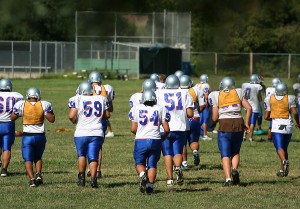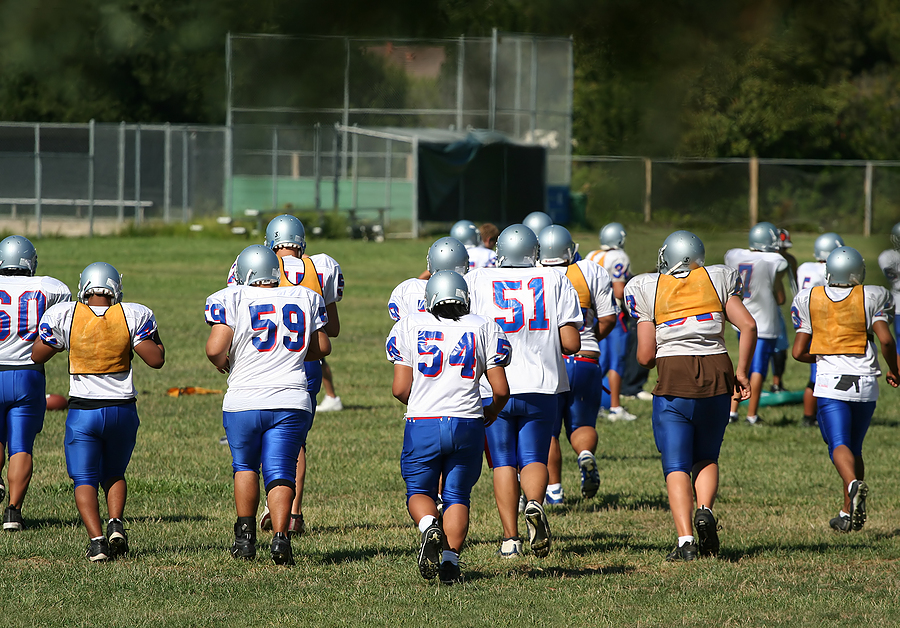The fear of long-term brain injury from concussions is contributing to a “Friday Night Flight,” with participation in prep football declining in the past decade, according to a survey of suburban Chicago schools.
The review of gridiron gusto at 87 public high schools by the (Arlington Heights) Daily Herald and the Chicago Sun-Times found a drop of more than 2,500 players – nearly 19 percent – since 2008.
Coaches and parents say there are several reasons. They include a greater variety of sports offered and a growing preference that athletes specialize in one sport. But they acknowledge that the decline has grown steeper in recent years because of the fear of the long-lasting impact of head injuries from concussions.
“I’ve had more parents who weren’t super excited about it in the first place, and then the kid suffers a concussion and the parents will say, ‘Don’t worry, Doc, he’s not playing anymore,”’ said Dr. Nathaniel Jones, an orthopedic surgeon and sports medicine expert at Loyola University Medical Center in Maywood.
Studies of brains of people who have received repeated head blows have shown signs of chronic traumatic encephalopathy, a degenerative disease that can prompt dementia and other illnesses. But the only way to diagnose CTE is by testing brain tissue after death.
The decline has hit Chicago, too. Chicago Public Schools officials would not provide figures on individual schools, but said the number offering football has decreased. In late September, the selective-enrollment Whitney Young Magnet High School canceled the balance of its varsity season because it couldn’t field enough players.
Even in Wheaton, home of the “Galloping Ghost,” the legendary University of Illinois and Chicago Bears running back Red Grange, the football craze has been slightly tempered. Wheaton Warrenville South High School has 149 players, down from 257 in 2008, a drop of 42 percent.
The picture is similar statewide. Participation in Illinois schools as a whole dropped 17 percent from 2007 to 2016, according to the National Federation of State High School Associations. The National Sporting Goods Association notes a 15 percent slide nationally.
Coaches and athletic directors say the game is safer today than ever. Proper tackling – not leading with the head – is emphasized and players make less contact during practices. Athletic trainers are better trained in identifying and assessing signs of concussions.
Dr. Erik Beltran, a neurologist at Northshore University Health System, gives concussion seminars at area high schools. He says some of the fears are fueled by what he called “sensational” media coverage of CTE. He says research is “limited in its scope and what kind of conclusions you can draw from it.”
Football and other contacts sports are safe if precautions are taken, Beltran said.
Was this article valuable?
Here are more articles you may enjoy.


 Lawsuit Filed in Case of Teen Who Died After Eating Spicy Chip as Part of Online Challenge
Lawsuit Filed in Case of Teen Who Died After Eating Spicy Chip as Part of Online Challenge  Warner Bros Discovery to Sue NBA Over Bid for Broadcast Rights, Source Says
Warner Bros Discovery to Sue NBA Over Bid for Broadcast Rights, Source Says  Allstate’s National General Sued by DOJ Over Alleged Force-Placed Insurance ‘Scheme’
Allstate’s National General Sued by DOJ Over Alleged Force-Placed Insurance ‘Scheme’  How California’s Homeowners Insurance Crisis is Affecting Brokers
How California’s Homeowners Insurance Crisis is Affecting Brokers 